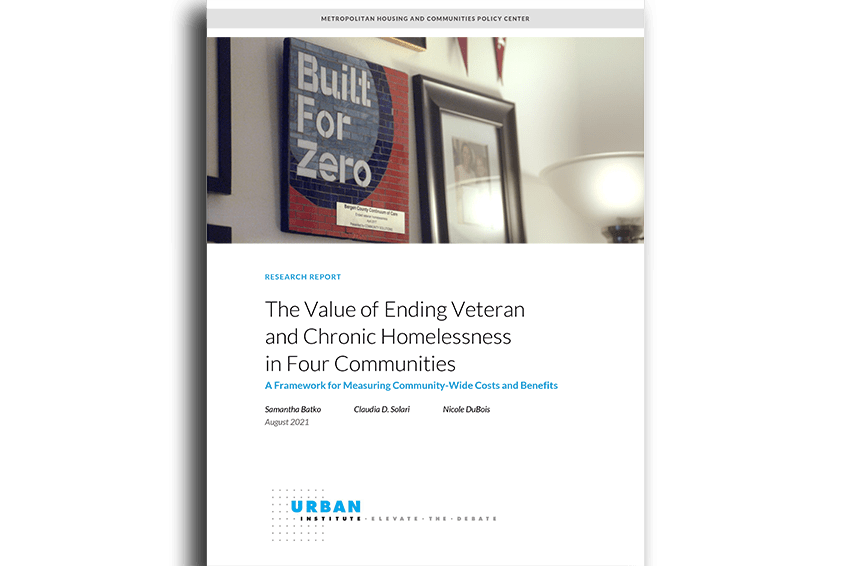Today, the Urban Institute published research that examines the community-level impacts of ending homelessness for a population. The research looks at the value of achieving functional zero for a population, a milestone that communities reach through a national initiative known as Built for Zero.
Through Built for Zero, more than 89 communities in the United States are working to measurably and equitably end homelessness. To date, 14 of those communities have achieved functional zero, a dynamic, sustained state where homelessness remains rare and brief for a population.
FUNCTIONAL ZERO: VETERAN

A community has achieved functional zero for veteran homelessness when there are fewer veterans experiencing homelessness than can be routinely housed in a month, with a minimum threshold of three.

FUNCTIONAL ZERO: CHRONIC

A community has ended chronic homelessness when the number of people experiencing chronic homelessness is zero, or if not zero, than either three or .1% of the total number of individuals reported in the most recent point-in-time count, whichever is greater.

The Urban Institute researched how building systems that can achieve and sustain this end state impacted four communities: Rockford, Illinois; Montgomery County, Maryland; Bergen County, New Jersey; and Lake County; Illinois.
As part of its research, the Urban Institute interviewed a broad range of community stakeholders and examined administrative data from the homelessness response systems operating across the four communities.
KEY FINDINGS
The research found that achieving functional zero for a population yields benefits across the entire community, including individuals both within and outside the target population; the homelessness response system; other systems (like health care, criminal legal, and emergency systems); and the broader community.
OUR NEXT STEPS & RECOMMENDATIONS
In future research, Community Solutions wants to further explore quantifying the costs and benefits of ending homelessness at a population level. We recognize that continuing to develop a deeper understanding of these elements will be essential to scaling and improving the work to end homelessness.
We will prioritize applying a racial equity lens to all future research.
More research is needed to understand the impacts of addressing homelessness as a system with a focus on population-level outcomes.
A DEEPER DIVE INTO THE FINDINGS
More people housed, and people spend less time experiencing homelessness
“There are a whole bunch of people who are housed, who are not living through the cycles of homelessness. That is a good in and of itself.”
a stakeholder in Montgomery County, maryland
“There are a whole bunch of people who are housed, who are not living through the cycles of homelessness. That is a good in and of itself,” said a stakeholder in Montgomery County.
Communities found that having a reduced population of people experiencing homelessness, and a coordinated system, enabled staff to promptly connect people to housing once they were identified. Stakeholders noted that the shift in focus to permanent housing also helped to drive a reduction in the amount of time people were experiencing homelessness.
In addition to the benefits of helping more people in the community have the dignity of housing, stakeholders reported that these outcomes reduced stress on staff. Homeless serving staff were less worried about people experiencing homelessness dying or experiencing violence.
Benefits to all people experiencing homelessness, beyond the target population
Data showed that the benefits of housing a target population can improve outcomes for other populations experiencing homelessness. People in both the target population and those outside of the initial target population spent less time homeless, used fewer programs, and were more likely to remain housed.
Benefits to driving progress for other populations experiencing homelessness
The study found that the data and coordinated system infrastructures implemented to help communities achieve functional zero for a target population benefited other populations. Reaching functional zero for the initial population also freed up more resources and staff time to drive progress for subsequent populations.
Since fewer people in the initial target population were experiencing homelessness after reaching functional zero, people in other populations were able to move closer to the top of the waiting list for resources. As a result, people were not “stuck waiting behind [the target population].”
Efficiency in use of resources and expanded capacity and resources for other populations and activities
Prior to achieving functional zero, communities operated in a manner that siloed resources and often left money unspent. But achieving functional zero required local actors to coordinate and break down siloed decision-making processes, which led to a more efficient use of resources. A common understanding of aims, values, and measures also eased a shift to a performance-based structure across the system.
Many stakeholders also shared how achieving functional zero supported their ability to secure resources. In Montgomery County, the local government increased investment due to the community’s ability to demonstrate its ability to make progress on homelessness. In Bergen County, community donations to the cause increased.
Stakeholders indicated that after reaching functional zero, their communities had the capacity to focus more on “upstream” activities that included helping people exit homelessness without entering a shelter program, known as diversion.
Less demand for other community systems
Across communities, stakeholders in systems outside homeless services, including the health system, police, fire and rescue, and adult protective services, reported decreased use of their systems after the community achieved functional zero for the target population.
“Most of the people who were constantly [being called about] have gotten the help they need and access to the facilities to help them,” said one stakeholder in Bergen County, New Jersey.
In three of the four communities, stakeholders reported reduced use of health-related services. A stakeholder in Montgomery County indicated that as the community approached functional zero for chronic homelessness, police experienced less pressure to sweep encampments.










